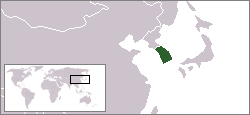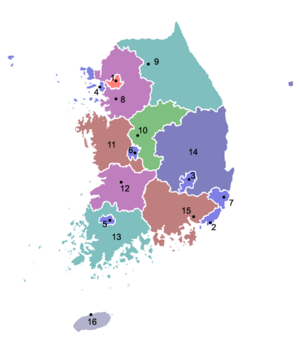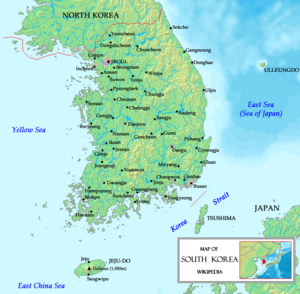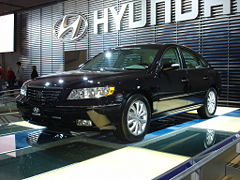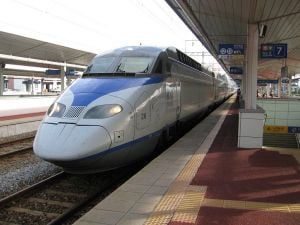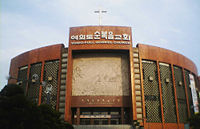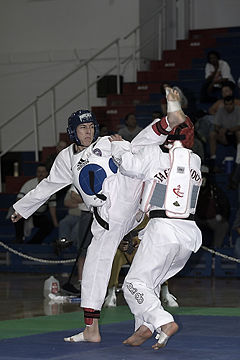South Korea
- For the history of Korea, see Korea.
| 대한민국 大韓民國 Daehan Minguk Republic of Korea | |||||
| |||||
| Motto: None (Unofficial: 널리 인간을 이롭게 하라(弘益人間) "Broadly benefit humankind" also translated as "Devotion to the welfare of humanity") | |||||
| Anthem: Aegukga (애국가; 愛國歌) Patriotic Hymn | |||||
| Capital (and largest city) |
Seoul 37°35′N 127°0′E | ||||
| Official languages | Korean | ||||
|---|---|---|---|---|---|
| Government | Presidential republic | ||||
| - President | Roh Moo-hyun | ||||
| - Prime Minister | Han Duck-soo | ||||
| Establishment | |||||
| - Independence declared | March 1 1919 (de jure) | ||||
| - Liberation | August 15 1945 | ||||
| - First Republic | August 151948 | ||||
| - United Nations Recognition | December 12 1948 | ||||
| Area | |||||
| - Total | 99,646 km² (108th) 38,492 sq mi | ||||
| - Water (%) | 0.3 | ||||
| Population | |||||
| - February 2007 estimate | 49,024,737 | ||||
| - Density | 480/km² 1,274/sq mi | ||||
| GDP (PPP) | 2006 estimate | ||||
| - Total | $1.196 trillion[1] | ||||
| - Per capita | $24,500 | ||||
| HDI (2006) | |||||
| Currency | South Korean won (KRW)
| ||||
| Time zone | Korea Standard Time (UTC+9) | ||||
| - Summer (DST) | not observed (UTC+9) | ||||
| Internet TLD | .kr | ||||
| Calling code | +82 | ||||
South Korea officially known as the Republic of Korea (ROK) (Korean: 대한민국, IPA: [tɛː.han.min.guk̚], listen ▶) is an East Asian state on the southern half of the Korean Peninsula. To the north sits North Korea (Democratic People's Republic of Korea), united until 1945 with South Korea. To the west, across the Yellow Sea, lies China and to the southeast, across the Korea Strait, lies Japan. Approximately one-half of South Korea's population lives in or near the capital Seoul, the second most populous metropolitan area in the world.
Korea traces its founding to 2333 B.C.E. by the legendary Dangun. Since the establishment of the modern republic in 1948, South Korea struggled with the aftermath of Japanese occupation (1910-1945), the Korean War (1950-1953), and decades of authoritarian governments, undergoing five major constitutional changes. While the government officially embraced Western-style democracy from its founding, presidential elections suffered from rampant irregularities. In 1987, South Korea held its first direct and fair presidential elections held, largely prompted by popular demonstrations. South Korea has been a vibrant multi-party democracy for two decades.
The South Korean economy has advanced rapidly since the 1950s and is now the 12th largest (nominal value) economy in the world. South Korea is also one of the world's most technologically advanced and digitally-connected countries; it has the third most broadband Internet users among the OECD countries[2] and is a global leader in electronics, digital displays, semiconductor devices, and mobile phones. South Korea also leads the world in the shipbuilding industry, headed by prominent companies like the Chosun Heavy Industries Co. Ltd.
Names
In the Korean language, South Korea is called Daehan Min-guk (Korean:대한민국 listen ▶, Hanja:大韓民國, literally "Great Han People's Nation"), or Hanguk for short (한국, "Han Nation," usually referring to Korea as a whole) or Namhan (남한, "South Han," referring to South Korea specifically). North Koreans refer to the South as Namjosŏn (남조선, "South Chosŏn").
The name Han dates back to the ancient Samhan Confederacies of the Proto-Three Kingdoms era of Korea.
History
Before division
Korea began with the legendary founding of Gojoseon in 2333 B.C.E. by Dangun. Limited linguistic evidence suggests possible Altaic origins of these people, whose northern Mongolian Steppe culture absorbed immigrants and invaders from northern Manchuria, Mongolia and China. The adoption of the Chinese writing system ("hanja" in Korean) in the 2nd century B.C.E., and Buddhism in the 4th century AD, had profound effects on the Three Kingdoms of Korea (Goguryeo, Baekje, Silla). Koreans later passed on these, as well as their own advances, to Japan.[3][4][5][6]
After the unification of the Three Kingdoms by Silla in 676, a single government ruled Korea, maintaining political and cultural independence until the nineteenth century, despite the Mongol invasions of the Goryeo Dynasty in the 13th century and Japanese invasions of the Joseon Dynasty in the 16th century.
In 1377, Korea produced the Jikji, the world's oldest movable metal print document.[7] In the 15th century, the Korean navy built and deployed Turtle ships, possibly the world's first ironclad warships, and during the reign of King Sejong the Great, scholars created the Korean alphabet hangul.
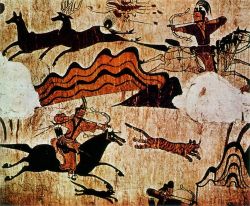
During the latter part of the Joseon Dynasty, Korea's isolationist policy earned it the Western nickname the "Hermit Kingdom." By the late 19th century, the country became the object of colonial designs by the imperial aggressors of Japan and Europe. In 1910, Japan annexed Korea and remained in power until the end of World War II in 1945.
After division
In 1945, Soviet Union and United States troops occupied the northern and southern halves of the country respectively. The two Cold War rivals helped establish governments sympathetic to their own ideologies, leading to Korea's current division into two political entities: North Korea and South Korea.
The Soviet Union and the democratic nations of the USA and Britian agreed on the establishment of an independent and unified Korea in the 1943 Cairo Declaration. While many Koreans wanted a national election to choose a leader for the whole country, the Communists refused to participate in elections by blocking entry into North Korea. Only South Korea held Democratic elections with Syngman Rhee winning the presidential election. The Soviet Union installed communist dictator Kim Il-sung. The United Nations recognized the Republic of Korea as the sole legitimate government of Korea at that time.
On June 25, 1950, the North invaded the South at the instigation of Stalin[8], tacitly approved by Mao Zedong. Thus began a bloody war that caused the deaths of more than 4 million civilians and soldiers alike, now referred to as the Korean War. The United Nations intervened on behalf of South Korea when it became apparent that the superior Communist forces would easily take over the entire country. The Soviet Union and China backed North Korea, with China sending millions of troops across the border. The war eventually reached a stalemate. The 1953 armistice split the peninsula along the demilitarized zone at about the original demarcation line. The two sides never signed a peace treaty, agreeing to a truce that has held until today. That leaves North and South Korea technically still at war.[9]
In 1960, a student uprising led to the resignation of president Syngman Rhee, whose government had become autocratic and corrupt. Then followed a period of profound civil unrest and general political instability. General Park Chung-hee led a military coup (the "5.16 coup d'etat") against the weak and ineffectual government the following year. Park took over as president from 1961 until his assassination in 1979, overseeing rapid export-led economic growth as well as severe political repression.
The year following Park's assassination, previously repressed opposition leaders all clamored to run for the presidential office causing considerable political turmoil. In 1980, General Chun Doo-hwan launched a coup d'etat against the transitional government of Choi Gyu Hwa, the former prime minister under Park and interim president, to assume the presidency. Chun's seizure of power triggered national protest asking for democrazation, particularly protests in Gwangju, South Cholla province. The protesters armed under the name of Civil Army. Chun sent in the special forces to suppress the city, brutally killing many students and civilians (Gwangju Massacre). Chun stated his intent to serve only a single term from the outset and eventually allowed direct presidential elections in 1988 under pressure from widespread popular demonstrations. That year, Seoul hosted the 1988 Summer Olympics.
Chaebols, family-owned conglomerates, drove South Korea's explosive economic development. Some of the most famous and richest Chaebols include Samsung, LG and Hyundai.
In 1996, South Korea became a member of the Organization for Economic Co-operation and Development. Despite a severe setback caused by the Asian financial crisis in 1997, the country re-emerged as a major economic power. In 2004, South Korea joined the "trillion dollar club" of world economies and, today, its standard of living approximates some of the less affluent countries in Western Europe such as Portugal and Spain.
In June 2000, as a part of South Korean president Kim Dae Jung's Sunshine Policy of engagement, a North-South summit took place in North Korea's capital Pyongyang. That year, Kim won the Nobel Peace Prize for his work for democracy and human rights and efforts at reconciliation between the two Koreas.[10] Since then, trade and investment between the two Koreas have increased dramatically as a result of regular contacts in relations and economic ties. South Korea is one of the Four Asian Tigers, along with Hong Kong, Taiwan and Singapore.
Government
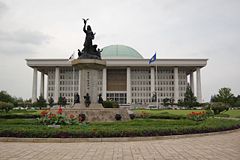
The government of South Korea is divided into three branches: executive, judicial, and legislative. The executive and legislative branches operate primarily at the national level, although various ministries in the executive branch also carry out local functions. Local governments act semi-autonomously, and have executive and legislative bodies of their own. The judicial branch operates at both the national and local levels.
The Constitution of the Republic of Korea determines South Korean government's structure. Although the Constitution has been revised several times since the first promulgation in 1948 (see History of South Korea), its characteristics have remained the same. With the exception of the short-lived Second Republic of South Korea, the country has had a presidential system with a relatively independent chief executive. As with most stable three-branch systems, a careful system of checks and balances is in place. For instance, the executive and legislature branches share in the appointment for the judges of the Constitutional Court. Likewise, the legislature sends passed resolutions of impeachment to the judiciary for a final decision.
Foreign relations
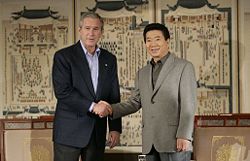
South Korea's foreign relations have been primarily concerned with North Korea and the neighboring countries of China, Japan, and Russia, as well as its main ally, the United States.[11]
The USA has been the primary driver in the establishment and initial sustenance of the South Korean government since the Korean War of 1950-1953. Since the 1990s the two nations have dealt successfully with differences in their policies towards North Korea. South Korea has been moving to take responsibility for major policy decisions affecting its own fate. Disputes have taken place on the time table for normalization of relations with North Korea, especially in light of attempts by North Korea to produce nuclear weapons and delivery systems that can reach the USA and Europe, as well as Japan. South Korea and China established formal diplomatic relations on August 24, 1992, despite previous hostility dating back to the Korean War.
South Korea and Japan signed the Treaty on Basic Relations between Japan and the Republic of Korea in 1965. South Korea's relations with Japan have been cooperative with the exception of several unsettled Korean-Japanese disputes, many of which stemmed from the period of Japanese occupation. Tthe Imperial Japanese Army conscripted more than 100,000 Korean civilians as officers and soldiers.[12] Longstanding issues such as Japanese war atrocities against Korean civilians, the visits by Japanese politicians to the Yasukuni Shrine honoring convicted war criminals, the re-writing of Japanese textbooks to overlook Japanese aggression during World War II, and the territorial disputes over Liancourt Rocks (known as Dokdo in Korean, Takeshima in Japanese) continue to trouble Korean-Japanese relations. In response to then-Prime Minister Junichiro Koizumi's repeated visits to the Yasukuni shrine, the President of South Korea Roh Moo-hyun suspended all summit talks between South Korea and Japan.[13]
Both North and South Korea continue to officially claim sovereignty over the entire peninsula. Despite longstanding animosity following the Korean War in 1950 (which has still not officially ended), the South and North have in recent times sought to establish a more conciliatory relationship. Events such as family reunifications and the Olympic Games, where the two Koreas entered the opening ceremonies together but still competed as separate teams, promised a gradual thaw in the North-South relationship (see Sunshine policy). North Korean missile tests in 1993, 1998 and 2006 have chilled progress toward reconcilliation.
In addition, South Korea maintains diplomatic relations with approximately 170 countries. The country has also been a member of the United Nations since 1991, joining at the same time as North Korea. On January 1, 2007, South Korean Foreign Minister Ban Ki-moon assumed the post of UN Secretary-General. Also, Korea has developed links with Association of Southeast Asian Nations as both a member of "ASEAN Plus three" and the East Asia Summit (EAS) Korea has concluded a Free Trade Agreement agreement with the United States in April 2007.
Military
The South Korean military is composed of the Republic of Korea Army (ROKA), Republic of Korea Navy (ROKN), Republic of Korea Air Force (ROKAF), and Republic of Korea Marine Corps (ROKMC), together with reserve forces. Many of those forces are concentrated near the border with North Korea. All South Korean males are constitutionally required to serve in the military, typically for a period of twenty-four months.
From time to time, South Korea has sent troops overseas to assist American-led coalitions, participating in every major conflict the United States has led since the Korean War. South Korea dispatched 320,000 troops to fight alongside American and South Vietnamese soldiers in the Vietnam War, with a peak strength of 50,000. Most recently, South Korea sent 3,300 troops in the form of the Zaytun Division to fight in northern Iraq, and is the largest contributor of troops after the U.S. and Britain.
The United States has stationed at least one division in the ROK since the Korean War at bases and camps throughout the country. Approximately 28,000 US soldiers stationed in Korea, most of them on one year unaccompanied tours, serve in South Korea.
South Korean soldiers are required to qualify at least 4th Dan Black Belt degree in Taekwondo. The Republic of Korea maintains an active duty military force of approximately 680,000, ranked 8th largest in active duty size in the world. Only the United States has more Marines than South Korea.
Administrative divisions
| Namea | Hangul | Hanja | |||||||||||||||||||||||||||||
|---|---|---|---|---|---|---|---|---|---|---|---|---|---|---|---|---|---|---|---|---|---|---|---|---|---|---|---|---|---|---|---|
| Special cities (Teukbyeolsi a) | |||||||||||||||||||||||||||||||
| 1 | Seoul | 서울특별시 | 서울特別市 | ||||||||||||||||||||||||||||
| Metropolitan cities (Gwangyeoksi a) | |||||||||||||||||||||||||||||||
| 2 | Busan | 부산광역시 | 釜山廣域市 | ||||||||||||||||||||||||||||
| 3 | Daegu | 대구광역시 | 大邱廣域市 | ||||||||||||||||||||||||||||
| 4 | Incheon | 인천광역시 | 仁川廣域市 | ||||||||||||||||||||||||||||
| 5 | Gwangju | 광주광역시 | 光州廣域市 | ||||||||||||||||||||||||||||
| 6 | Daejeon | 대전광역시 | 大田廣域市 | ||||||||||||||||||||||||||||
| 7 | Ulsan | 울산광역시 | 蔚山廣域市 | ||||||||||||||||||||||||||||
| Provinces | |||||||||||||||||||||||||||||||
| 8 | Gyeonggi-do | 경기도 | 京畿道 | ||||||||||||||||||||||||||||
| 9 | Gangwon-do | 강원도 | 江原道 | ||||||||||||||||||||||||||||
| 10 | Chungcheongbuk-do | 충청북도 | 忠淸北道 | ||||||||||||||||||||||||||||
| 11 | Chungcheongnam-do | 충청남도 | 忠淸南道 | ||||||||||||||||||||||||||||
| 12 | Jeollabuk-do | 전라북도 | 全羅北道 | ||||||||||||||||||||||||||||
| 13 | Jeollanam-do | 전라남도 | 全羅南道 | ||||||||||||||||||||||||||||
| 14 | Gyeongsangbuk-do | 경상북도 | 慶尙北道 | ||||||||||||||||||||||||||||
| 15 | Gyeongsangnam-do | 경상남도 | 慶尙南道 | ||||||||||||||||||||||||||||
| Special self-governing province (Teukbyeoljachi-do a) | |||||||||||||||||||||||||||||||
| 16 | Jeju | 제주특별자치도 | 濟州特別自治道 | ||||||||||||||||||||||||||||
a Revised Romanization.
b See also Special cities of Korea and Provinces of Korea.
Geography and climate
South Korea occupies the southern portion of the Korean Peninsula, extending approximately 680 miles (1,100 km) from the Asian mainland. A mountainous peninsula, the Yellow Sea flanks Korea to the west, and the Sea of Japan (East Sea). to the east. The Korea Strait and the East China Sea touches the southern tip of the peninsula. The country's total area is 38,462.49 square miles or 99,617.38 square kilometres.[14]
South Korea naturally divides into four general regions: an eastern region of high mountain ranges and narrow coastal plains; a western region of broad coastal plains, river basins, and rolling hills; a southwestern region of mountains and valleys; and a southeastern region dominated by the broad basin of the Nakdong River. South Korea's land is mountainous, and most unsuitable for farming]]. Lowlands, located primarily in the west and southeast, constitute only 30% of the total land area.
About three thousand islands, mostly small and uninhabited, lie off the western and southern coasts. The country's largest island, with an area of 1,845 square kilometres (712 sq mi), Jeju Island sits about 100 kilometres (about 60 mi) off the southern coast of South Korea. Jeju is also the site of South Korea's highest point: Halla-san, an extinct volcano, reaches 1,950 metres (6,398 ft) above sea level. Other islands of South Korea include Ulleungdo and the disputed Liancourt Rocks (Dokdo).
The local climate is relatively temperate, with precipitation heavier in summer during a short rainy season called jangma, and winters that can be bitterly cold. In Seoul, the average January temperature range is -7°C to 1°C (19°F to 33°F), and the average July temperature range is 22°C to 29°C (71°F to 83°F). Winter temperatures range higher along the southern coast and considerably lower in the mountainous interior. Rainfall concentrates in the summer months of June through September. Late summer typhoons bring strong winds and heavy rains frequently to the southern coast. The average annual precipitation varies from 1,370 millimetres (54 inches) in Seoul to 1,470 millimetres (58 inches) in Busan.
Economy
South Korea is a major international economic power with the twelfth largest economy in the world (eleventh largest by purchasing power parity) and the third largest in Asia, behind only Japan and China (fourth behind China, Japan, and India by purchasing power parity). China constitutes South Korea's largest trading partner and export market today,[15] As one of the Four Asian Tigers, achieving explosive economic growth through exports of manufactured goods.
South Korea ranked one of the poorest countries in Asia in the 1950s.[16] At the end of World War II, the country had inherited a colonial economic system designed solely for Japan's needs. The Korean War (1950-1953) had destroyed much of the country's infrastructure.[17] After the war, South Korea became heavily dependent on U.S. aid.[18]
Following the military coup led by General Park Chung-hee in 1962, South Korea embarked on a series of ambitious five-year plans for economic development. Emphasis shifted to foreign trade with the normalization of relations with Japan in 1965 and resulted in a boom in trade and investment. Rapid expansion, first into light and then heavy industries, followed in the 1960s and 1970s. During that period, the South Korean economy grew at an average annual rate of 8.6%.[19]
That phenomenal growth earned the title "Miracle on the Han River," the Han River being the main river that runs through the nation's capital and largest city, Seoul. In the 1980s and 1990's, rocketing growth continued as South Korea transformed itself from an exporter of mostly textiles and shoes into a major global producer of automobiles, electronics, shipbuilding, steel and, later, high-technology products such as digital monitors, mobile phones, and semiconductors.
The South Korean model of encouraging the growth of large, internationally competitive companies through easy financing and tax incentives led to the dominance of the family-controlled conglomerates. Those companies, known as chaebol, flourished under the support of the Park regime.[20] Some such as Hyundai, Samsung, LG and SK Company became global corporations. In 2004, South Korea joined in the trillion dollar club of world economies.[21]
Since the Asian financial crisis of 1997, the corporate landscape changed considerably from massive bankruptcies and government reforms. The crisis exposed longstanding weaknesses in South Korea's economy, including high debt-to-equity ratios, massive foreign borrowing, and an undisciplined financial sector. That led to two rounds of financial and industrial restructuring; once in 1997 and again following the collapse of Daewoo in 1999.[22] Daewoo's collapse has been recorded as one of the largest bankruptcies in world history. [8] By 2003, just over one-half of the 30 largest chaebol from 1995 remained.[23]
Between 2003 and 2005, economic growth has slowed to a sustainable 4% per year, an enviable figure for most the world's economies.[24] Rapid export growth, primarily to China, offset a downturn in consumer spending, attributed to massive personal credit card debt. In 2005, the government proposed labor reform legislation and a corporate pension scheme to help make the labor market more flexible, and new real estate policies to cool property speculation.[25] In 2006, South Korean economy has increased to a growth rate to 5.1%, with the economic forecast for 2007 positive.
Moderate inflation, low unemployment, an export surplus, and fairly equal distribution of income characterizes the South Korean economy.[26][27][28] South Korea continues to strive to maintain global competitiveness, although the country has been reluctant to open the job market to foreigners.
Transportation
An extensive network of railways, highways, bus routes, ferry services, and air routes criss-crosses the country. All cities have intercity and intracity bus systems. Major cities also have express bus terminals.
Highways in South Korea are classified highways (expressways/motorways), national highways, and various classifications below the national level. Korea Highway Corporation operates the toll highways and service amenities en route. South Korea has about 3,000 kilometers of national highways. Most tourist and freight transportation use highways. Korail provides frequent train service to all major South Korean cities. Two rail lines, Gyeongui and Donghae Bukbu Line, to North Korea are now being reconnected. The Korean high-speed railway system, KTX, provides frequent high-speed service along Gyeongbu and Honam Line. Major cities have subway systems, including the popular Seoul Subway. Korail commuter lines are already linked with Seoul subway system and several commuter lines connected with Busan, Daegu subway system are under construction.
The main international airport is Incheon International Airport. South Korea has eight international airports and seven domestic airports. South Korea's major international air carriers are Korean Air and Asiana Airlines. About seventy one international passenger and cargo airlines operate frequent flight services between Korea and many nations throughout the world.
Demographics
Most South Koreans live in urban areas, due to rapid migration from the countryside during the country's rapid economic expansion in the 1970s, 1980s and 1990s.[29] The capital city of Seoul is also the country's largest city and chief industrial center with 10.3 million inhabitants in 2006, making Seoul one of the most populated single cities in the world.[30] Other major cities include Busan (3.65 million), Incheon (2.63 million), Daegu (2.53 million), Daejeon (1.46 million), Gwangju (1.41 million) and Ulsan (1.10 million).[31]
The population has also been shaped by international migration. Following the division of the Korean peninsula after World War II, about four million people from North Korea crossed the border to South Korea. That trend of net entry reversed over the next forty years due to emigration, especially to the United States and Canada. South Korea's burgeoning economy and improved political climate in the early and mid-1990s slowed the high emigration rates typical of the previous decade. Many of those who left the country returned.
Although small, the percentage of non-Koreans in South Korea has risen in the early twenty-first century. Officially, as of April 2005, the total number of known foreign labourers in South Korea stood at 378,000, 52% of whom work menial factory jobs without proper immigration visas.[32] The foreign workforce mainly comes from South Asian and Southeast Asian nations, although many workers from the former Soviet Union countries as well as some from Nigeria have entered. In addition to those workers, about 11,000 expat English teachers and around 31,000 US military personnel live and work in Korea.[33]
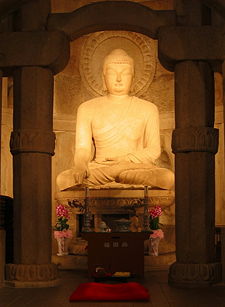
As of 2005, approximately 22 million or 46.5% of the South Korean population express no religious preference.[34] Of the remainder, 10.7 million are Buddhist, 8.6 million are Protestant, 5.1 million are Catholic, and less than half a million belong to various minor religions including Jeungsando and Wonbuddhism. The largest Christian church in South Korea, Yoido Full Gospel Church, is located in Seoul and has approximately 780,000 members (2003 estimate). Including Yoido Full Gospel, eleven of the world's twelve largest churches are located in Seoul (see Korean Christianity). South Korea is also the second largest missionary sending nation on earth, after the U.S.[35] 45,000 Muslim believers reside in Korea as well as approximately 100,000 temporary workers from Muslim countries.[36]
Culture
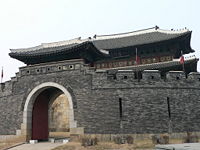
South Korea and North Koreashare their traditional culture, but the two Koreas have developed distinct contemporary forms of culture since the division of the Korean peninsula in 1945. The South Korean Ministry of Culture and Tourism actively encourages the traditional arts, as well as modern forms, through funding and education programs.[37]
Korean art and culture have developed and transformed through cultural influences from many countries. Prior to the 19th century, cultural infusions came primarily from China. Koreans adapted many Chinese art forms with innovation and skill, creating distinctively Korean forms. For many centuries, Korean forms of metalwork, sculpture, painting, and ceramics flourished throughout the Korean peninsula, passing on to neighboring countries like Japan. In modern times, Western and particularly the US influences have been strongest although influences from Europe, especially Germany, have been pronounced.
In the aftermath of Japanese occupation, the Korean government had sought to restrict Japanese cultural influences until 1999. Recently, Japanese influences have been particularly controversial; for example, the K-pop singer Hyori sparked a national controversy. In recent times, Korean pop culture has become popular in Asia and beyond, earning the name Hallyu or "Korean Wave." Korean pop culture has also made headway in Japan, with Korean singers like BoA, and television dramas like Daejanggeum and Winter Sonata finding success.[38] Recent Korean films such as Oldboy and Oasis have also received international acclaim.
Technology, including feature-rich cell phones and pervasive online gaming, heavily dominates the contemporary culture of South Korea. South Korea today has one of the highest expansion of high-speed internet access to households in the world.[39] Digital multimedia broadcasting now allows South Koreans to watch television on their cell phones.
South Korea's entertainment industry has grown substantially since the 1990s, producing Asia-wide successes in music, television, and film in a phenomenon known as the "Korean wave." The country still retains centuries-old customs and traditions, such as its unique cuisine and ancestor worship.
Sports
Taekwondo, a popular martial art, originated in Korea. Taekwondo roughly translates to the way of punching and kicking, although sometimes translated as the way of the hands and feet. The South Korean military incorporated taekwondo into military training in 1961, while taekwondo became an official Olympic sport in 2000. Other Korean martial arts include subak and taekkyeon.
Baseball, first introduced to Korea in 1905 by an American missionary named Phillip Gillette, has become the most popular spectator sport in South Korea.[40] The Korea Baseball Association, established in 1982, became the first South Korean professional sports league. During the 2006 World Baseball Classic, South Korea reached the final four before losing to Japan. Prior to that final match, the South Korean team had been the only undefeated team, beating Japan twice and the United States once. Other popular sports in South Korea include basketball, football, golf, tennis and ice hockey. Women's golf is especially strong, with forty-five South Koreans playing on the world's leading women's tour, the U.S. LPGA Tour, including stars such as future Hall of Famer Se Ri Pak.
South Korea's Olympic teams have also traditionally performed at a championship level in archery, shooting, badminton, table tennis, fencing, weightlifting, boxing, judo, short track speed skating, marathon, taekwondo, kumdo, wrestling as well as handball and field hockey. In 1988, South Korea hosted the Summer Olympics in Seoul. Korea has conducted an ongoing campaign to have a future Winter Olympics held in Pyeongchang County. South Korea has hosted the Asian Games in 1986 and 2002. South Korea and Japan jointly hosted The 2002 FIFA World Cup, and South Korea became the first Asian team to reach the semi-finals. The Korea Republic national football team, also known as the "Taeguk Warriors," qualified for the 2006 FIFA World Cup in Germany for their sixth consecutive World Cup.
During the 2006 Winter Olympics in Turin the South Korean short track team dominated their event, taking home six of the eight gold medals available as well as three silvers and one bronze. Skaters Ahn Hyun Soo and Jin Sun-Yu became the second and third persons in the Games to win three gold medals.
Video games have taken on a sport-like presentation in South Korea, Starcraft emerging as the most popular. Although in the entertainment class, the professional leagues televise on MBC Game and OnGameNet with announcers, professional players and big-name sponsors such as Adidas. The three major professional Starcraft leagues are Proleague, MSL and OSL.
International rankings
| Organisation | Title | Ranking |
|---|---|---|
| International Monetary Fund/World Bank | Gross Domestic Product (nominal) | 12 out of 183 |
| CIA World Factbook | Gross Domestic Product (PPP) | 11 out of 227 |
| World Bank | Ease of Doing Business | 23 out of 175 |
| World Economic Forum | Global Competiveness | 24 out of 125 |
| Heritage Foundation/The Wall Street Journal | Index of Economic Freedom | 31 out of 157 |
| The Economist | Worldwide quality-of-life index, 2005 | 30 out of 111 |
| Reporters Without Borders | Worldwide press freedom index | 31 out of 167 |
| Transparency International | Corruption Perceptions Index | 42 out of 163 |
| United Nations Development Program | Human Development Index | 26 out of 192 |
Notes
- ↑ https://www.cia.gov/library/publications/the-world-factbook/geos/ks.html#Econ
- ↑ OECD Broadband statistics
- ↑ "Yayoi Period History Summary," BookRags.com; Jared Diamond, "Japanese Roots," Discover 19:6 (June 1998); Thayer Watkins, "The Genetic Origins of the Japanese"; "Shinto - History to 1900," Encyclopædia Britannica; "The Yayoi period (c. 250 B.C.E.–c. AD 250)," Encyclopædia Britannica.
- ↑ "Korean Buddhism Basis of Japanese Buddhism," Seoul Times, June 18, 2006; "Buddhist Art of Korea & Japan," Asia Society Museum; "Kanji," JapanGuide.com; "Pottery," MSN Encarta; "History of Japan," JapanVisitor.com.
- ↑ (1993) in Delmer M. Brown (ed.): The Cambridge History of Japan. Cambridge University Press, 140-149. ; George Sansom, A History of Japan to 1334, Stanford University Press, 1958. p. 47. ISBN 0-8047-0523-2
- ↑ From Paekche to Origin of Yamato
- ↑ World's oldest printed Doc
- ↑ [1]
- ↑ South Korea. U.S. Department of State. Retrieved 2006-09-16.
- ↑ Korean President Kim-Dae Jung Receives the 2000 Nobel Peace Prize. UCLA Center for East Asian Studies. Retrieved 2006-09-16.
- ↑ A Brief History of the US-Korea Relations Prior to 1945 [2]
- ↑ A Brief History of the US-Korea Relations Prior to 1945. [3]
- ↑ [4]
- ↑ The estimated area rises steadily from year to year, possibly due to land reclamation. 행정구역(구시군)별 국토적. Korea Statistical Information Service. Retrieved 2006-03-27.
- ↑ Trade Policy Outlook for Second-term Bush Administration
- ↑ Working in South Korea. College Journal (Wall Street Journal). Retrieved 2006-09-16.
- ↑ Template:Cite web url=http://www.asia.msu.edu/eastasia/NorthKorea/history.html
- ↑ Cumings (1997), 305-307; Nahm (1996), p. 448.
- ↑ Yang (1999), p.594.
- ↑ See Cumings 1997, chapter 6.
- ↑ Korea, South. CIA Factbook. Retrieved 2006-10-06.
- ↑ KOIS (2003), pp. 238-239.
- ↑ 18 out of 30, according to Country Studies: South Korea. The Economist (2003-04-10). Retrieved 2006-04-06.
- ↑ GDP - Rank order - Real Growth Rate. CIA Factbook. Retrieved 2006-09-15.
- ↑ Anti-Speculation Measures. Hankooki Ilbo. Retrieved 2006-09-15.
- ↑ Field Listing - Inflation Rate - (consumer prices). CIA Factbook. Retrieved 2006-09-15.
- ↑ Field Listing - Unemployment Rate. CIA Factbook. Retrieved 2006-09-15.
- ↑ Field Listing - Exports. CIA Factbook. Retrieved 2006-09-15.
- ↑ South Korea. CIA Country Studies. Retrieved 2006-04-22.
- ↑ World City Populations. Retrieved 2006-04-04.
- ↑ Populations for all cities as of 2005, By city and province. NSO Database. Retrieved 2006-04-22.
- ↑ Migrants Want Flexible Employment System. Korea Times December 30, 2005. Retrieved 2006-04-04.
- ↑ US military figures as of 2005, from [5] (Excel file) Tim Kane Global U.S. Troop Deployment, 1950-2003
- ↑ According to figures compiled by the South Korean National Statistical Office. 인구,가구/시도별 종교인구/시도별 종교인구 (2005년 인구총조사). NSO online KOSIS database. Retrieved 2006-08-23. This should not be confused with other figures which report only the percentage of the religious population that are Buddhist, Christian, etc.
- ↑ Korean Christian missionaries. Christianity Today. Retrieved 2006-09-15.
- ↑ Islam takes root and blooms
- ↑ Associated Organizations. MCT Website. Retrieved 2006-04-11. See also Mission and Goal. Korea Cultural Administration website. Retrieved 2006-04-11.
- ↑ Winter Sonata: Wiseman, Paul. Korea's romantic hero holds Japan in thrall. USA Today December 9. Retrieved 2006-04-11. Daejanggeum: [6] BoA: [7]
- ↑ According to the 2006 Face of the Web survey by Ipsos, Japan now leads Korea in internet connections per capita. Ipsos press release. Retrieved 2006-04-03.
- ↑ KOIS (2003), p.632.
ReferencesISBN links support NWE through referral fees
- Cumings, Bruce (1997). Korea's place in the sun. New York: W.W. Norton. ISBN 0-393-31681-5.
- KOIS (Korea Overseas Information Service) (2003). Handbook of Korea, 11th ed.. Seoul: Hollym. ISBN 1-56591-212-8.
- Nahm, Andrew C. (1996). Korea: A history of the Korean people (2nd ed.). Seoul: Hollym. ISBN 1-56591-070-2.
- Yang, Sung Chul (1999). The North and South Korean political systems: A comparative analysis (rev. ed.). Seoul: Hollym. ISBN 1-56591-105-9.
- Yonhap News Agency (2004). Korea Annual 2004. Seoul: Author. ISBN 89-7433-070-9.
- Dennis Hart (2003). From Tradition to Consumption: Constructing a Capitalist Culture in South Korea. Seoul: Author. ISBN 89-88095-44-8.
- Michael Breen (2004). The Koreans: Who They Are, What They Want, Where Their Future Lies . St. Martin's Griffin. ISBN 0312326092.
External links
- Korea.net: Gateway to Korea
- Korea National Statistical Office
- South Korea in Encyclopædia Britannica
- CIA World Factbook entry on South Korea
- A Country Study: South Korea in the Library of Congress
- Travel guide to South Korea from Wikitravel
- {{{2}}} at the Open Directory Project
- South Korea at the Yahoo! Directory
- Galbijim Wiki, including non-encyclopedic content for Korea
- Main cities of South Korea, satellite views and geographical coordinates
Timeline · List of monarchs · Military history
Gojoseon · Jin · Proto-Three Kingdoms (Buyeo • Okjeo • Dongye • Samhan) · Gaya
Three Kingdoms (Goguryeo • Baekje • Silla) · Unified Silla · Balhae · Later Three Kingdoms · Goryeo (Mongol invasion)
Joseon (Seven Year War) · Korean Empire · Japanese rule (Independence movements • March 1st Movement • Provisional Government)
Division of Korea (USAMGIK) · Korean War · North Korea · South Korea
North Korea
Government (President • Chairman • Premier • Supreme People's Assembly • Presidium) · Elections · Political parties · Workers' Party of Korea · Human rights · Nuclear program · Military · Foreign relations · "Juche"
South Korea
Government (Constitution • President • Prime Minister • Assembly) · Elections · Political parties · Human rights · Military · Foreign relations (Sunshine policy)
North Korea
List of companies · Currency · Communications · Transportation
South Korea
List of companies · Chaebol (Samsung • Hyundai • LG • SK) · "Miracle on the Han River" · Currency · 1997 financial crisis · Communications · Transportation · Real estate
Korean Peninsula · Regions · Provinces (historical) · Special cities · DMZ
Mountains (Baekdudaegan • Baekdusan • Kumgangsan • Seoraksan • Jirisan • Hallasan)
Islands (Jeju-do) · Rivers (Tumen • Yalu • Han • Nakdong) · Lakes
North Korea
Administrative divisions · Cities (Pyongyang)
South Korea
Administrative divisions · Cities (Seoul • Busan) · Environment
North Korea
South Korea
People (List • Adoptees • Koreatown) · Language (Hangul • Hanja) · Names
Religion (Buddhism • Shamanism • Christianity) · Philosophy · Confucianism · Mythology · Cinema · Drama
Korean martial arts (Taekwondo • Hapkido) · Ssireum · Swords
Cuisine (Kimchi • Galbi • Bulgogi) · Tea ceremony
North Korea
"Juche" · Arirang Festival · Sports · Education · Religion · Tourism
South Korea
Korean wave · K-pop · Sports · Education · Religion · Tourism · Marriage
Art
Pottery · Painting · Calligraphy · Architecture · Music (Pansori • Arirang) · Literature (Poetry • Sijo • Gasa) · Cinema (Animation • List of films)
| SARs | |||
Sometimes included: Singapore · Vietnam · Russian Far East
Afghanistan · Armenia · Azerbaijan1 · Bahrain · Bangladesh · Bhutan · Brunei · Cambodia · China, People's Republic of · China, Republic of (Taiwan)2 · Cyprus · Egypt3 · Georgia1 · India · Indonesia4 · Iran · Iraq · Israel · Japan · Jordan · Kazakhstan1 · Korea, Democratic People's Republic of · Korea, Republic of · Kuwait · Kyrgyzstan · Laos · Lebanon · Malaysia · Maldives · Mongolia · Myanmar · Nepal · Oman · Pakistan · Philippines · Qatar · Russia1 · Saudi Arabia · Singapore · Sri Lanka · Syria · Tajikistan · Thailand · Timor-Leste (East Timor)4 · Turkey1 · Turkmenistan · United Arab Emirates · Uzbekistan · Vietnam · Yemen3
For dependent and other territories, see Dependent territory and List of unrecognized countries.
1 Partly or significantly in Europe.
2 The Republic of China (Taiwan) is not officially recognized by the United Nations; see Political status of Taiwan.
3 Partly or significantly in Africa.
4 Partly or wholly reckoned in Oceania.
Potential future members ![]() Timor-Leste
Timor-Leste ![]() Russia
Russia
Credits
New World Encyclopedia writers and editors rewrote and completed the Wikipedia article in accordance with New World Encyclopedia standards. This article abides by terms of the Creative Commons CC-by-sa 3.0 License (CC-by-sa), which may be used and disseminated with proper attribution. Credit is due under the terms of this license that can reference both the New World Encyclopedia contributors and the selfless volunteer contributors of the Wikimedia Foundation. To cite this article click here for a list of acceptable citing formats.The history of earlier contributions by wikipedians is accessible to researchers here:
The history of this article since it was imported to New World Encyclopedia:
Note: Some restrictions may apply to use of individual images which are separately licensed.


